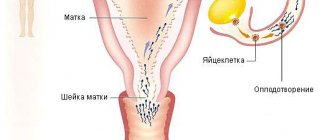Features of the medicine
The medication is produced in the form of soft capsules, which have a yellowish color and white oily contents.
Inside the capsule there is sunflower oil and soy lecithin, as well as the active ingredient, which is micronized progesterone. The shell is made of gelatin with the addition of titanium dioxide and glycerin. The medicine with a dosage of 100 mg has a round shape and is packaged in 28 capsules per pack, and “Utrozhestan” with a dose of 200 mg is presented in oval capsules, which are packaged in cardboard boxes of 14 pieces.
The product is sold by prescription, the average price of one package is 400 rubles. The shelf life of the capsules is 3 years from the release date marked on the box.
When is it prescribed for pregnant women?
The main reason for using Utrozhestan in the first trimester is the threat of miscarriage caused by progesterone deficiency. Taking capsules helps raise hormone levels, thereby eliminating hypertension and other dangerous symptoms of threatened miscarriage. Some women are prescribed the drug even before conception, which promotes embryo implantation and normal gestation if this is prevented by a lack of progesterone. The medication is in demand for IVF, habitual abortion, endometriosis, fibroids and similar problems.
The use of capsules in later stages (28-34 weeks) is often due to changes in the cervix, which can trigger premature labor. In such patients, progesterone prevents shortening and softening of the cervix, preventing the development of cervical insufficiency, which helps to carry the baby to term normally.
Utrozhestan: until what week of pregnancy should you take it
Utrozhestan is a hormonal drug that is prescribed both to regulate the cycle and treat various gynecological diseases, and to support the normal course of pregnancy. Many women are interested in up to what week of pregnancy they can take a progesterone-based product.
To answer this question, you will need to familiarize yourself in detail with how the drug affects the body of a pregnant woman.
After pregnancy, the drug promotes the transition of the endometrial layer of the uterus to a special state, which ensures the normal development of the embryo until the process of formation of the placenta.
At later stages, progesterone eliminates the tone of the uterus, which allows you to maintain pregnancy.
Indications for use
Not everyone knows why progesterone therapy is prescribed. Utrozhestan can be recommended for use by women to prevent miscarriage if she is at risk for miscarriage or has a reduced level of progesterone in the blood.
A woman is included in the risk group if:
- History of spontaneous miscarriage in early pregnancy caused by gestagen insufficiency
- Carrying out the procedure of in vitro fertilization (with IVF)
- Taking Utrozhestan or Duphaston at the planning stage
- Preterm birth in the second trimester
- Diagnosing shortening of the cervix after a woman becomes pregnant.
How exactly to take Utrozhestan during pregnancy should be checked with a gynecologist; if necessary, he will tell you why hormonal support is needed and how long it will last.
Oral administration of capsules
To prevent miscarriage, take hormonal capsules in a dosage of 100-200 mg twice a day during the 1st trimester. If there is pain in the lower abdomen, it is possible to extend the prescribed treatment. Not every woman knows how many weeks she will need to take the capsules. Usually, drug withdrawal begins no earlier than 23-28 weeks.
If there is a risk of premature labor, a woman should take a progesterone-based drug every 6-8 hours at a dosage of 400 mg until the lower abdomen stops pulling and other symptoms of uterine tone disappear.
After eliminating the pathological symptoms, pregnant women do not stop taking progesterone. It is necessary for a woman to drink 200 mg of progesterone in capsules three times a day. Therapy with Utrozhestan continues until the 36th week of pregnancy.
If a pregnant woman misses taking Utrozhestan, she will need to take the missed dose as soon as possible. In the future, you should follow the regimen prescribed by your doctor and do not miss the time of taking hormonal capsules.
Intravaginal use
In the event of a threat of miscarriage and to prevent a habitual miscarriage due to a lack of natural progesterone, you will need to place capsules in the vagina in a dosage of 100-200 mg twice a day (the recommended interval between administration of the drug is 12 hours). It is necessary for the woman to insert the capsules as deeply as possible into the vagina. Utrozhestan is prescribed until the 2nd trimester of pregnancy. In some cases, it is recommended to discontinue the drug up to 34 weeks.
The regimen for using the drug Utrozhestan after IVF is determined individually. Intravaginal administration of capsules is prescribed from the moment of hCG injections until the end of the 2nd trimester. The highest dosage of the drug is 600 mg, which is divided into three applications. The withdrawal of Utrozhestan should be gradual.
Cancellation Features
If a woman takes the drug during the 1st and 2nd trimester of pregnancy, then its withdrawal should not be abrupt. For example, if a woman drinks 200 mg of progesterone per day, then for 5 days.
the dosage must be reduced by half over the next 5 days. cancel completely. Therefore, it is recommended to start reducing the dose of Utrozhestan at 30 weeks of pregnancy.
It will be possible to complete hormone therapy at approximately 31 or 32 weeks.
After discontinuation of the hormonal drug, minor bleeding may appear, which is not a pathology; it should completely stop within a few days.
At 35-37 weeks, it is necessary to undergo an ultrasound examination to assess the progress of pregnancy and determine the length of the cervix.
Contraindications
You should not start hormonal therapy if:
- Excessive sensitivity to the components of Utrozhestan
- Serious violations by the SSS
- Tendency to thrombosis and with the development of thrombophlebia earlier
- Diagnosing incomplete abortion
- Oncological processes in the mammary gland and internal genital organs
- Porphyria
- Discovery of bleeding of unknown origin.
Utrozhestan should be prescribed with extreme caution in the presence of renal failure and impaired liver function. It is important to assess the likely risks and expected benefits of the treatment. During hormonal therapy, you will need to monitor basic blood counts.
Source: https://lekhar.ru/lekarstva/gormonalnye-preparaty/utrozhestan-do-kakoj-nedele-mozhno/
How is it used?
There are two ways to use the capsules - oral and vaginal. The second is more in demand during pregnancy because:
- ensures faster absorption of the hormone and its effect on the uterus;
- reduces side effects on the digestive tract;
- helps with early toxicosis.
The dosage and regimen of use are prescribed by the doctor individually. Some expectant mothers are prescribed the medicine in a daily dose of 200-400 mg, others – 600-800 mg, it all depends on the indications, symptoms and tolerability of the drug.
The dose can be taken once, then the entire daily dose is swallowed or inserted into the vagina before bedtime. However, 2-dose regimens are much more often used, when a woman takes most of the dose at night, and less in the morning.
Why is it being phased out gradually?
When prescribing Utrozhestan to an expectant mother, the doctor will definitely tell you that you will need to discontinue the medication carefully and very slowly. It is especially important to complete the dose correctly if the reason for prescribing the capsules was the threat of miscarriage. In this case, abrupt withdrawal may cause undesirable consequences in the form of a resumption of dangerous symptoms.
If the drug was prescribed before conception, it should not be abruptly stopped when the woman is pregnant . With such actions, the activity of the muscular lining of the uterus will increase, which can provoke bleeding and rejection of the fertilized egg. Abrupt refusal of treatment in the later stages is also not recommended , because it can cause premature birth.
When is it cancelled?
If Utrozhestan was prescribed when there was a threat of miscarriage and was used throughout the first trimester, then its withdrawal often begins at 12-13 weeks. However, for some patients, the medication is not discontinued for a little longer - until 16-20 weeks, when a fully formed placenta will provide a normal level of progesterone in the blood.
If the drug is prescribed in the second trimester to prevent premature birth, withdrawal begins from the 30th week in order to completely abandon Utrozhestan by the 34th obstetric week.
What effects does the medicine have?
Utrozhestan is an absolute analogue of natural progesterone, which is formed first in the corpus luteum of the ovary, and then in the placenta. Sometimes, due to progesterone deficiency, a lot of problems arise with carrying an embryo, so a hormonal drug in the form of capsules ensures the maintenance of the correct level of progesterone in the blood of a pregnant woman. In addition, utrogestan has the following positive properties:
- suppression of excess estrogen influence;
- regulation of androgen levels with a decrease in male hormones when they are in excess;
- decongestant effect;
- relaxation of the muscular system of the uterus (tocolytic effect);
- calming effect;
- suppression of local immunity, which is necessary to maintain pregnancy.
The best therapeutic effect will be when used vaginally. The dosage is selected by the doctor. There is no need to be afraid - an overdose is impossible, because when the capsules are inserted into the vagina, the drug enters the blood in minimal quantities. In this case, the local effect on the organs of the reproductive system will be optimal.
How to stop treatment correctly?
For each woman using Utrozhestan, an individually selected withdrawal regimen is used. She must take into account the duration of pregnancy and the dosage of the medication. Most often, the amount of hormonal substance is reduced every 3-7 days, carefully monitoring the patient’s condition.
If any alarming symptoms occur after reducing the dose, the woman should go back to the previous dosage at which the woman felt normal.
Expectant mothers receiving maximum doses of the hormone require the most attention. If after the first reduction in the amount of the active substance for 5 days there are no dangerous signs, then you can continue with the withdrawal.
An approximate drug withdrawal regimen for a woman who took it in the 1st trimester with a threat of miscarriage at a dose of 200 mg per day looks like this:
- at 11-12 weeks, a woman uses 100 mg in the morning and evening;
- at week 13 - only 100 mg at night;
- at week 14 – 100 mg every other day before bedtime;
- at week 15 the medication is completely stopped.
If the threat of miscarriage is serious, the woman complains of spotting, abdominal pain and other symptoms, she is prescribed an increased dosage, for example, 400 mg of progesterone daily until 13-14 weeks (200 mg twice a day).
Next, the medication is discontinued according to the following scheme:
- at week 15, a woman should take 200 mg at night and 100 mg in the morning;
- at week 16 – 200 mg before bedtime;
- at week 17 – 100 mg at night;
- after 18 weeks .
The use of Utrozhestan during the IVF protocol also requires higher doses, which are divided into 2 doses, and the completion of treatment occurs by 20-21 obstetric weeks.
Here is an approximate withdrawal regimen for a woman receiving 800 mg of a hormonal substance every day:
- at week 15, the expectant mother should take 400 mg in the morning (2 capsules with a dosage of 200 mg) and the same amount of hormone in the evening;
- at week 16, the morning dose is reduced, that is, the woman will receive 200 mg in the morning, and the evening dose remains 400 mg;
- at week 17, the dosage at night is also reduced, so the pregnant woman takes 200 mg of the hormone twice a day;
- at week 18 you should take 200 mg at night and only 100 mg in the morning;
- at week 19 – 100 mg twice a day;
- at week 20 - only 100 mg at bedtime;
- At 21 weeks, use is stopped.
If pregnancy, despite the prescription of Utrozhestan, cannot be maintained, the medication can be discontinued abruptly.
Often this increases the contractile activity of the uterus and allows it to independently reject the dead fertilized egg, so curettage is no longer necessary. Such a cancellation can only be carried out if there are reliable signs of miscarriage - after an ultrasound, blood tests and a medical examination. They do not use any special regimens; they simply stop taking the capsules.
How to stop the drug
You must stop taking the medication correctly, in accordance with your doctor’s recommendations. It is very important to accurately and consistently follow all the advice, from the dose to when to stop taking the medication. In each specific case, the cancellation scheme may be different, but the general principles should be as follows:
- gradualism;
- each dose is reduced once every 3-7 days, depending on the doctor’s recommendations;
- It is imperative to monitor the condition and symptoms.
The maximum doses should be canceled most carefully when spontaneous miscarriage has been prevented with the help of Utrozhestan. Switching to average dosages is possible only when there are no dangerous symptoms for 5 days. Minimum quantities of the drug can be approached only after an ultrasound examination and confirmation of the complete absence of the risk of premature termination of pregnancy.
If the cervix is shortened at 16-20 weeks, treatment with Utrozhestan will need to be carried out for a long time and in large doses. Regular ultrasound monitoring is required: however, even if the safety of the cervix is confirmed, the drug cannot be discontinued. The doctor will give recommendations on gradually stopping Utrozhestan after 30 weeks. During the remaining 4 weeks, it will be necessary to reduce the dose from the maximum until the drug is completely discontinued by week 34.
Taking the correct dosage of the drug is of great importance when treating with Progesterone. When necessary, the maximum number of capsules should be used. If the pathological symptoms no longer bother you, then you can gradually reduce the amount of the drug, but taking into account the doctor’s recommendations. It is strictly forbidden to abruptly discontinue the drug. Prescribing Utrozhestan by a doctor has the main goal of maintaining pregnancy and giving birth to a healthy baby.
Why it is impossible to abruptly cancel treatment with Utrozhestan during pregnancy 4 — Ratings: 87
Utrozhestan during pregnancy - reviews
Utrozhestan capsules are well tolerated by women. They do not suppress the production of female hormones, therefore they are not addictive, do not participate in metabolic processes, do not affect weight and do not provoke hormonal imbalance in the child. Utrozhestan helps many women every day to conceive and carry a baby, as evidenced by many reviews.
Many responses are left by women who were prescribed Utrozhestan during pregnancy for tone. After the start of therapy, the women’s condition rapidly stabilized, and the threat of miscarriage passed. There are also reviews about the effectiveness of Utrozhestan in the prevention of premature birth of a baby, which could be caused by pathologies of the cervix.
Utrozhestan is a highly effective remedy that allows women with hormonal disorders to conceive and bear a healthy baby. But it is a hormonal drug and can only be taken under the supervision of an obstetrician-gynecologist.
Contraindications
You should not start hormonal therapy if:
- Excessive sensitivity to the components of Utrozhestan
- Serious violations by the SSS
- Tendency to thrombosis and with the development of thrombophlebia earlier
- Diagnosing incomplete abortion
- Oncological processes in the mammary gland and internal genital organs
- Porphyria
- Discovery of bleeding of unknown origin.
Utrozhestan should be prescribed with extreme caution in the presence of renal failure and impaired liver function. It is important to assess the likely risks and expected benefits of the treatment. During hormonal therapy, you will need to monitor basic blood counts.
All iLive content is reviewed by medical experts to ensure it is as accurate and factual as possible.
We have strict sourcing guidelines and only link to reputable sites, academic research institutions and, where possible, proven medical studies. Please note that the numbers in parentheses ([1], [2], etc.) are clickable links to such studies.
If you believe that any of our content is inaccurate, out of date, or otherwise questionable, please select it and press Ctrl + Enter.
Utrozhestan is used during pregnancy as an analogue of progesterone.
[1], [2], [3], [4], [5]
Recommendations
The main task at week 29 is to preserve the health of the unborn baby and create all the conditions for completing the process of intrauterine development.
- At any time of the year, you should avoid drafts and hypothermia , as well as communication with people who have signs of acute respiratory infections. In case of infection with colds, it will be difficult to prescribe effective treatment due to the danger of most drugs for the child.
- On the advice of a doctor, you can do special exercises to facilitate the process of future childbirth.
- It's time to start preventing possible postpartum depression . You should not watch videos about the birth process or films with a negative plot. Any information coming from outside must be positive.
- If sleeping on the bed has become uncomfortable, it’s time to buy new bedding : a pillow and a mattress that meet the necessary requirements.
- You should strictly monitor the weight of the bags : the weight of the cargo carried should not exceed 3 kg.
- You should refrain from eating products of dubious quality , heavily seasoned with flavorings and preservatives. For now, the baby only eats what his mother eats, so there is no harm.
Utrozhestan during pregnancy - what is it prescribed for?
Utrozhestan is indicated for women for the correction of diseases caused by inferiority of the corpus luteum. Administration can take place orally or vaginally, and depends on the pathology.
Internal administration of Utrozhestan during pregnancy is carried out in the presence of the following obstetric pathologies:
- risk of miscarriage;
- prevention of premature birth.
Outside of pregnancy, Utrozhestan is prescribed to eliminate the following gynecological pathologies:
- premenstrual disorders;
- infertility due to luteal phase disturbance;
- disturbance of the ovulatory process (anovulation, disovulation);
- gestagen deficiency in menopause;
- mastopathy;
- precimacteric period.
Vaginal use of Utrozhestan is appropriate for:
- inability to swallow capsules orally (toxicosis, diseases of internal organs);
- impossibility of conception due to infertility;
- threat of miscarriage;
- risk of premature onset of labor.
Advice! If a woman is confirmed to have a lack of progesterone, Utrozhestan during pregnancy is prescribed in any form, regardless of gestational age.
Why is the drug needed?
You can start taking utrozhestan before pregnancy. The doctor will prescribe the medicine long before conception in the following cases:
- against the background of gynecological problems, when it is necessary to create the right conditions in the uterus;
- with artificial insemination;
- with hormonal imbalance in a woman’s body;
- with recurrent miscarriage, when a woman has had 2 or more miscarriages in the past.
Utrozhestan can be taken orally or used vaginally. Regardless of the method of application, it is very important to follow the dose prescribed by your doctor. The specialist will definitely explain how much medicine you need to take and for how long.
Properly selected preconception treatment will create maximum conditions for successful conception. After receiving a positive test result, a woman should immediately consult a doctor to begin maintenance therapy.
Belly size
A large belly can cause back pain and some pressure on internal organs, which can result in heartburn or indigestion in a pregnant woman.
Also, an enlarged uterus can put pressure on the vena cava when lying down, which can lead to a sharp deterioration in well-being, so it is strictly not recommended for a pregnant woman to sleep on her back.
At week 29, the uterus rises 8-10 cm above the level of the navel. Due to the increase in abdominal volume, it is necessary to wear only loose-fitting clothing that does not restrict movement.
Which is better: Duphaston or Utrozhestan during pregnancy
To maintain pregnancy, not only Utrozhestan can be prescribed. An analogue of this drug is Duphaston. It is also considered a progestin, but contains a synthetic version of progesterone. While Utrozhestan contains natural progesterone of plant origin. Otherwise, these two drugs are completely identical.
The attitude of obstetricians and gynecologists towards these two drugs is different. Duphaston has long been used in obstetric practice, so its effect on pregnancy has been well studied. In addition, the synthetic form of progesterone provides a more pronounced therapeutic effect. Therefore, obstetricians-gynecologists give preference to Duphaston rather than Utrozhestan during pregnancy when there is a threat of miscarriage.
Utrozhestan is a relatively new drug with a milder effect on the body. But many doctors are afraid to prescribe it during gestation, citing little experience with its use in this period. At the same time, Utrozhestan is much better tolerated by women and extremely rarely causes them to feel unwell.
It is impossible to say which of these two drugs is better. Therefore, the doctor’s appointment depends on his experience, the woman’s condition and the effectiveness of the chosen treatment.
Physiological changes
At the 29th week of pregnancy, the load on all organs of the pregnant woman continues to increase. As before, you may experience back pain and a feeling of discomfort in the stomach or intestines. In addition to the above symptoms, the following changes may occur in the body of the expectant mother:
- Edema may occur , which may indicate incipient gestosis. It is recommended to pay attention to possible symptoms of swelling and regularly have your urine tested.
- In the warm season, as well as when the heating of the home is too intense, a feeling of lack of air and slight suffocation may occur . To prevent this situation from occurring, it is recommended to frequently ventilate the room and maintain an optimal air temperature at home.
- Sweating increases , so it is necessary to take a shower at least once a day and observe personal hygiene rules.
- If you experience pain, itching or discomfort in the hemorrhoidal area, you should immediately consult a doctor and begin the necessary treatment.
information There may also be mild pain in the abdominal area, which is not a cause for concern. But if alarming signs do not disappear within several hours, this is a reason to contact a medical facility.
Utrozhestan reviews
Due to side effects, burning in the vagina, baking candles, this hormonal medicine does not always leave positive reviews.
But women are ready to endure this because they want to give birth to a healthy baby, and not have painful experiences about a miscarriage. And Utrozhestan helps with this. Not everyone likes its price; some girls consider it a bit expensive.
Remember, hormonal drugs are not toys. This is not a slice of lemon in tea that we drink to avoid getting sick. Utrozhestan and similar products have a serious impact on women's health. They should only be prescribed to you by a doctor, and not by you yourself.
“I couldn’t bear a child for several years (I constantly had miscarriages in the early stages. I went to another doctor and he suggested Utrozhestan suppositories. When I became pregnant again, I was very afraid that I would have a breakdown again... I was all on my nerves. But the suppositories helped! I already at 5 months (pah-pah-pah). Girls, listen to good doctors" Maria
Utrozhestan during pregnancy - instructions
The drug fully compensates for the lack of progesterone without disturbing the woman’s natural hormonal balance. Proper treatment does not cause complications, does not contribute to excess weight gain or worsening pregnancy. But the effectiveness of replacement therapy during gestation depends on the adequacy of the prescribed dose and the general dosage regimen.
Utrozhestan during pregnancy - dosage
The treatment course of Utrozhestan depends on the method of its use, the course of pregnancy, and the severity of progesterone deficiency.
- Oral administration of Utrozhestan involves the administration of 200-300 ml of the drug in several doses. For example, 100 ml in the morning, and the rest of the dose at night.
- The Utrozhestan regimen during pregnancy to prevent unscheduled onset of labor looks like this: the expectant mother takes 400 ml of the drug every 7-8 hours until the condition stabilizes, or according to the regimen suggested by the doctor. After the condition improves, the dose of Utrozhestan is reduced to 200 ml. The maintenance dose is taken until the 36th gestational week. A longer course of treatment is not recommended.
- Intravaginal use of the drug involves the administration of 200 ml of progesterone daily. If necessary, it is allowed to increase the dose of Utrozhestan during pregnancy to 400 ml or more.
- To delay premature birth, Utrozhestan 200 during pregnancy is taken from 22 to 36 gestational weeks. If there is a threat of miscarriage, a woman is prescribed 200-400 ml of Utrozhestan vaginally at the same time with an interval of 12 hours. Therapy lasts up to 12 gestational weeks.
There are no problems with how to insert Utrozhestan during pregnancy. The procedure is quite simple and painless. Before removing the capsule from the blister, you need to wash your hands, then take the capsule and insert it into the vagina in a position comfortable for the woman. The use of an applicator is allowed. After the procedure, the woman needs to lie down for some time so that the contents of the capsule dissolve and the substances penetrate into the tissue of the vaginal membrane.
Utrozhestan - contraindications during pregnancy
Utrozhestan may be contraindicated in a pregnant woman if she has the following diseases:
- thrombophlebitis;
- liver damage of various etiologies;
- varicose veins;
- porphyria;
- undiagnosed bleeding;
- neoplasia of the genital organs and mammary glands.
Gestagens tend to retain water in tissues and affect the growth of hormone-dependent tumors. Given this effect of Utrozhestan, its use during pregnancy is limited for the following diseases:
- hypertension;
- epilepsy;
- bronchial asthma;
- kidney dysfunction;
- migraine;
- diabetes;
- cardiovascular abnormalities;
- lupus erythematosus;
- mastopathy;
- benign neoplasms.
Considering the high risk of thromboembolic and metabolic complications, Utrozhestan should be immediately discontinued if the following symptoms develop:
- visual impairment;
- blood clot formation;
- venous insufficiency;
- severe headache, including migraine attack.
Important! Utrozhestan is indicated for stopping miscarriage only in cases of diagnosed progesterone deficiency. If the cause of the miscarriage is a genetic disorder, sexually transmitted infections or physical disorders, Utrozhestan is contraindicated.
Utrozhestan during pregnancy - side effects
Negative consequences from treatment are rare. Sometimes, if treatment rules are not followed or individual intolerance occurs, some disruptions in the functioning of various organs and systems are possible.
From the reproductive system:
- mammalgia;
- amenorrhea;
- bleeding from the birth canal.
Nervous system disorders:
- sleepiness;
- absent-mindedness;
- headache;
- dizziness;
- depression.
Gastrointestinal disorders:
- diarrhea;
- nausea;
- occasional vomiting;
- constipation.
Skin damage:
- itching;
- acne;
- hives;
- yellowness of the skin;
- chloasma.
After vaginal administration of Utrozhestan during pregnancy, side effects are local in nature and manifest themselves in the form of unpleasant sensations in the vagina - itching, swelling, burning, hyperemia.
The following adverse reactions may also occur:
- decreased libido;
- localized alopecia;
- thromboembolism;
- short-term fluid retention in tissues;
- minor weight fluctuations;
- hirsutism;
- anaphylactic shock.
On a note! Women are often afraid of discharge after Utrozhestan during pregnancy. In fact, moderate yellow discharge with an oily structure is normal throughout the course of treatment.
How to cancel Utrozhestan during pregnancy
Utrozhestan is a hormonal drug, therefore it needs to be gradually withdrawn so as not to provoke a hormonal imbalance. To successfully discontinue the drug without consequences, the daily dose is reduced by 100 ml every week. If the dose taken is low enough, it is reduced by 50 ml at intervals of three days. At the stage of dose reduction and until Utrozhestan is completely discontinued during pregnancy, the woman is constantly monitored so that she does not start bleeding.
Instructions for use and dosage
The specialist prescribes the method and duration of taking Utrozhestan, based on the degree of progesterone deficiency and the characteristics of pregnancy.
The capsules are taken orally as follows:
- the daily dosage is 200-300 ml, which is taken throughout the day;
- Usually 100 ml of the drug is taken in the morning, and the rest - before bed.
For prevention when there is a threat of premature birth, the drug is taken according to the following scheme:
- 400 ml every 7-8 hours until you feel better;
- 200 ml every 7-8 hours until 36 weeks of pregnancy.
For intravaginal use, the drug is administered into the vagina in a dosage of 200 ml every day. The procedure is carried out while lying on your side, preferably at night, so that the medicine can take full effect.
With the existing threat of premature birth, the drug is used daily in a dosage of 200 ml from 22 to 36 weeks.
If there is a threat of miscarriage at the beginning of pregnancy, Utrozhestan is taken daily at the same time in the morning and evening, observing an interval of 12 hours, in the amount of 200 or 400 ml until the 12th week of pregnancy.
Since Utrozhestan is a hormonal drug, its withdrawal should occur gradually. The most appropriate and successful method of discontinuation of therapy and prophylaxis is to reduce the dosage to 100 mg every week or 50 mg every 3 days.
During withdrawal, the pregnant woman should be regularly monitored by a doctor so that if bleeding occurs, all necessary measures can be taken.
Fetal size and development
Upon reaching the 29th week of pregnancy, the full height of the fetus is 37 cm, body weight reaches 1250 g.
The following changes occur in the child’s body and appearance during this period:
- the body acquires the shapes and proportions characteristic of newborn children;
- the amount of adipose tissue continues to increase and reaches 4% of the total weight of the fetus;
- tooth enamel begins to form, although at this stage the teeth are still located inside the gums and will begin to erupt only a few months after the baby is born;
- Mucus plugs are removed from the baby's nasal openings - the baby is preparing for independent breathing.
information The child is already quite viable: the survival rate during childbirth during this period exceeds 90%.
Sources
- https://o-krohe.ru/beremennost/preparaty/utrozhestan/
- https://beremennuyu.ru/dlya-chego-naznachayut-utrozhestan-pri-beremennosti-instrukciya-po-primeneniyu-utrozhestana-vo-vremya-beremennosti
- https://baby-calendar.ru/calendar/29-nedelya-beremennosti/
[collapse]









